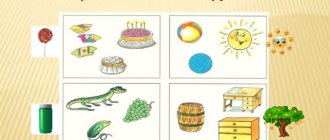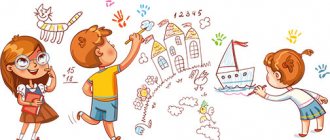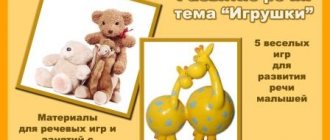Speech development games for younger preschoolers
In children 3-4 years old, their active vocabulary is filled faster than at any other age, the sound design of words improves, discoveries in the meaning of concepts occur, phrases become more developed, and the sound culture of speech is laid.
But the most characteristic ones are the replacement and swallowing of sounds, rearrangement of sounds and syllables, violation of the syllabic structure (for example, abbreviation of words: “asiped” instead of “bicycle”), incorrect stress, and others. All these imperfections are temporary, but require appropriate training. With children of this age, speech development can only be done through play.
1. "Poultry yard."
Goal: learn to pronounce 3-4 syllables on one exhalation, train sound production, imitate the voices of birds.
Prepare animal toys: chicken, goose, rooster, chicken. Tell a story about someone you met in the poultry yard, imitating the sounds of poultry. Then, inviting your child to the poultry yard, show the toys one by one and invite the child to expressively voice the birds he sees through onomatopoeia: ko-ko-ko; ha-ha-ha; quack-quack-quack; peek-a-boo; pee-pee-pee, etc.
2. “Make-believe” - the game is useful for children who replace sounds in words. Helps develop correct pronunciation of sounds and words.
Take a bunny toy or show it in a picture. Ask your child with a smile: “Is this a T-shirt?” To begin, use a substitute sound that is different from the one the child uses. Shake your head to help your child understand the game. “Or maybe it’s a seagull?” - try to cheer up the baby with further versions. Only then reproduce the child’s mistake: “Is this a polar cod?” And then: “Is this a bunny?”
As soon as the child understands the meaning of the game, do not give him any hints, but listen to how independently he determines the correct sound. Different words can be used in this game exercise. Be sure to include those that your child has difficulty pronouncing.
3. “What can drive” , “What can fly ” and similar - a game to isolate a certain sound in words and consolidate pronunciation.
For example, training the pronunciation of the sound s(s). To play, you need to select pictures depicting vehicles and objects that have this sound in their names. Possible selection: sled, chair, airplane, bicycle, boot, scooter, snowmobile, trolleybus, table, bus, snowflake and others. The pictures are turned over so that the baby cannot see them right away. The child takes the picture, voices the object he sees and explains whether it can ride.
Note: an adult must ensure that the preschooler correctly and expressively pronounces the sound s(s) and clearly pronounces the word with this sound.
Finger Theater
Finger theater is an exciting game that:
- Stimulates the development of fine motor skills;
- Introduces the child to the following concepts of shape, color, size;
- Helps develop spatial perception (the concepts of “right”, “left”, “next to each other”, etc.);
- Develops imagination, memory, thinking and attention;
- Helps develop vocabulary and activates speech functions;
- Forms creative abilities and artistic skills;
- Introduces basic mathematical concepts.
For children aged 1 – 2 years (using the example of the fairy tale “Kolobok”):
- First, introduce your child to the characters in the fairy tale. Invite your child to look at and touch the figures. Then put each character on your finger in turn and describe it.
- Introduce your child to the name of each finger on his hand. For example, you can say this: “I have a Kolobok sitting on my index finger.”
- Then act out a fairy tale for your child. Place the characters on your fingers and cross your arms. Start telling the story, raising your fingers with the characters as the action progresses. For example, the fairy tale “Kolobok” can be told as follows. Thumbs up with Grandma character. Tell your child that today this hero will bake Kolobok. Rhythmically tap the heels of your palms against each other without releasing your fingers. At the same time, say: “Grandma is kneading the dough.” Using the same principle, play up the appearance of each character.
For children aged 2 – 4 years (using the example of the fairy tale “Kolobok”):
- Ask your child if he remembers the fairy tale “Kolobok”. Remind him if necessary.
- Then ask your child to place the characters on the table in the order they appear in the story. At the same time, ask to characterize each of them according to the principle: “Grandma is old, kind, caring; Kolobok is round, ruddy, mischievous,” etc.
- Ask your child questions about the fairy tale. For example: “Why did grandma decide to bake Kolobok? Why did he leave his grandmother and grandfather? Who did he meet on the way?
- Then act out a fairy tale in front of the little spectator using a finger theater.
- At the end, ask your child to act out a fairy tale in front of you using a finger theater. If necessary, prompt him.
Speech games for children 5-6 years old
Middle preschool age is marked by new achievements in speech development. An increase in the active vocabulary (from 2500 to 3000 words) allows the child to express his thoughts more accurately.
But the growth of vocabulary and the desire to use complex sentences in speech often lead to difficulties and grammatical errors.
Therefore, at this stage of preschool age it is necessary to use games to develop coherent and dialogic speech.
Games for the formation of coherent speech
Speech is a way of conveying your thoughts. Therefore, it is very important to teach a preschooler to express his thoughts to his interlocutor in such a way that a new statement continues and complements the previous one, so that the message is filled with semantic content. The proposed games will help in the formation of those skills on which the development of coherent speech in preschool children is based.
- "Sad bunny." Goal: to teach how to explain the meanings of words and write short stories. Pick up a toy bunny and tell your child a fairy tale: “Once a bunny who lived in the forest with his mother heard about the New Year. He became interested to know what it was? He asked his mother, his friend Little Bear, and even his grandfather Hedgehog. Nobody could tell him. Now he sits and cries. Explain to the bunny what kind of holiday this is?” Note: The plot and toy change in each game.
- “Two Cards” is a game of making sentences with given words. Show your preschooler two cards with pictures and ask them to say something using words that represent the objects depicted on the cards. For example, the cards show a bicycle and a plate. You can make a sentence: A bicycle with a flower is drawn on the bottom of the plate.
- “Choose the right word.” Goal: to learn to use words correctly in composed sentences. Say the beginning of the phrase, inviting the preschooler to continue it. For example, “Vova’s red... (balloon) burst, and he... (cryed).” Or: “Sitting high on a tree and cawing... (a crow).”
Games for the development of dialogic speech
At the age of five, communication with peers actively develops. The use of dialogic speech becomes especially important for children. But preschoolers still don’t know enough about it. Dialogue-developing games and exercises that can be practiced both in the middle group of kindergarten and at home come to the rescue.
- "Interesting day." Goal: development of narrative, dialogic speech skills. On the way home or at dinner in the evening, ask your child to tell you how he spent his day, what was especially interesting. Ask questions sequentially, encouraging the child to speak and listen to the next question. Be sure to tell us how you spent your day. This tradition will help the child structure his thoughts, teach him to choose the main thing, instill the skill of narrative speech, and strengthen the ability to conduct a dialogue.
- “What can an object tell?” — the game develops verbal logical thinking and dialogical speech. Name an object and ask the child what this object could tell about itself if it could speak. For example, what would a tree, a shovel, the sun say...
- "Where is the mistake?" - one of the favorite children's games, which encourages you to listen carefully to your interlocutor and develops the ability to determine the meaning of the text. Voice the proposal to the child, and then ask if everything is correct. If he finds errors, let him correct them.
How to develop a child's speech
We continue the conversation about the development of a child’s speech , which began in the first part of the article devoted to this problem.
The movements of the body and organs involved in speech production have common mechanisms, therefore the development of fine motor skills of the hands directly affects the development of speech. It is for this reason that finger exercises for the development of speech in children should take a strong place in your activities with your child.
Training finger movements will, as it were, prepare a platform for further speech development. You can start training your baby’s fingers within the first 5 months.
Now let's see how you can help your child master their native speech, teach him correct pronunciation, constructing phrases and forming thoughts.
Remember: classes should be held in the most easy, fun and playful way possible. Then they will bring real benefits and bring real pleasure to both of you.
A set of measures for speech development (to be carried out at home):
- Development of fine motor skills
- Speech gymnastics
- Logorhythmics
We do not mention here such areas of work on speech development as speech therapy massage, special exercises for practicing various sounds, developing phonemic hearing, and some others. They are the area of application of exclusively professional knowledge and skills. Here it is better to trust a specialist rather than try to cope with this task yourself.
Benefits for developing fine motor skills:
- Matryoshka dolls
- Velvet paper
- Plasticine
- Mosaic
- Laces
- Beans, peas
- Semolina
- Salty dough
- Counting sticks
- Multi-colored clothespins
- Beads
- Cloths with sewn buttons
- Stencils
- Massage ball
- Wooden construction sets
Fine motor skills:
- Passive gymnastics - massage for the development of fine motor skills.
- Active gymnastics - games for the development of fine motor skills: poems and nursery rhymes, finger games, finger theater.
Didactic games for speech development in older preschoolers
In the sixth year of life, the development of speech in preschool children progresses noticeably, and it becomes more complex structurally. But, despite the significant expansion of vocabulary, the preschooler is still far from fluently using words. Games for speech development are often practiced in the older group if the child attends kindergarten. At home, parents must initiate them. Didactic games are suitable for speech development in older children.
1. “What comes first, what comes next” – helps children learn to write stories. The child is offered any picture with a plot. He must think and tell what happened at the beginning of this story, in the middle (picture) and how it all ended.
2. “A fairy tale with sounds.” Goal: learn to select words for a given sound. Invite your child to compose a fairy tale together: “Once upon a time there were two kittens and a mother cat. One kitten had a name that had the sound “M” in it. What was his name? And the other's name began with the sound "P". What was his name? They went fishing and caught a fish whose name contains the sound “S”. What kind of fish is this?..." and so on.
3. “Tender words.” The game is aimed at training to form diminutive forms of adjectives. Invite children to change words in sentences to affectionate ones. For example:
- The ball is blue, and the ball...(blue).
- The leaf is smooth, and the leaf... (smooth).
- The cat is fluffy, and the kitten... (fluffy).
Note: At the beginning of the game, it is necessary to show the child the transformation of words using an example.







